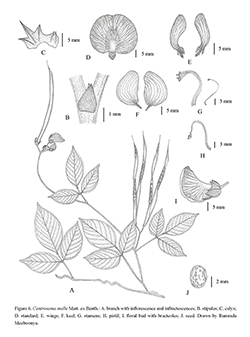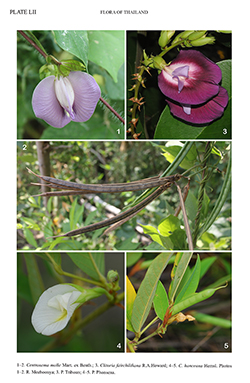e-Flora of Thailand
Volume 4 > Part 3.3 > Year 2023 > Page 518 > Leguminosae-Papilionoideae > Centrosema
1. Centrosema molle Mart. ex Benth.wfo-0000166036
Commentat. Legum. Gen.: 55. 1837; Ann. Wiener Mus. Naturgesch. 2: 119. 1839. Fig. 6. Plate LII: 1–2.
Accepted Name : This is currently accepted.
Synonyms & Citations :
Description : Herb; stems twining, all vegetative parts with pilose and hooked hairs. Stipules deltoid, 2–2.5 by 1–1.3 mm, apex acute, base truncate, margin entire. Leaves: petioles 1.5–5 cm long; rachis 0.5–1.5 cm long. Leaflets: petiolules 2–4 mm long; blade elliptic, broadly elliptic, ovate or oblong, 2.5–8.5 by 1.5–4.5 cm, apex attenuate, acuminate or acute and apiculate, base rounded, truncate or cuneate, sometimes subcordate, margin entire, both surfaces sparsely to densely hairy; lateral veins 6–12 pairs; stipels subulate, 2–3 by ca 0.5 mm, striate, apex acuminate, base truncate, margin entire. Inflorescences 2–4-fascicled, nodose-pseudoracemes; peduncles 1.5–5 cm long, pilose and hooked hairs; axis 1–8 mm long, sparsely pilose and hooked hairs; bracts 2, broadly ovate, ca 1.5 by 1 mm, striate, apex acuminate, base truncate, outside pilose and hooked hairs, inside glabrous. Flowers 1–2 per fascicle, pale purple, pale pink or white; pedicels 0.5–1.5 cm long, glabrous or glabrescent; bracteoles appressed to base of calyx tube broadly ovate or ovate, 0.7–1 by 0.5–0.6 cm, striate, apex acute, base truncate, outside pubescent and hooked hairs, inside glabrous. Calyx: tube 3.5–5 by 6–7 mm; two upper lobes connate, apex slightly divided to shallow lobes, 0.8–2 mm long; the lowest of three lower lobes much longer than the rest, lanceolate or linear, ca 7 by 1.5–2.5 mm, apex acute, two lateral lobes subtriangular, 3–4 by 2–2.5 mm, apex acute; outside pubescent and hooked hairs, inside glabrous. Corolla outside sparsely to densely pubescent; standard pale purple or pale pink with yellowish white or white spot at centre inside, often with purple lines around the spot, suborbicular, 2–4 by 2–4 cm, apex emarginate or retuse, claw 5–7 mm long; wings pale purple or pale pink on upper part, white on lower part, obovate, 2–2.8 by 0.6–1 cm, apex obtuse, base with 2 opposite appendages, 1–3 mm long, claw ca 3 mm long; keel pale purple or pale pink on upper part, white on lower part, boat-shaped, 1.8–2.7 by 0.8–1.5 cm, apex obtuse, claw 3.5–5 mm long. Stamens: filaments white, 1.8–3 cm long; vexillary filament shorter than the others; anthers suborbicular, 1–1.5 by 1–1.5 mm. Ovary linear, sparsely pubescent; stigma hairy. Pods linear, 6–15 by 0.5–0.6 cm, apical beak 0.8–1.8 cm long, base shortly stipitate, glabrous, glabrescent or sparsely pubescent along ridges; fruit stalk 0.5–1.5 cm long. Seeds 7–19, brown with black or dark brown dots, slightly compressed, oblong or suborbicular, 3.5– 4.5 by 3–3.5 mm.
Thailand : NORTHERN: Chiang Mai (Chiang Dao, Chom Thong, Doi Saket, Doi Suthep, Hot, Mae Rim, Mueang), Chiang Rai (Mae Sai), Phayao (Mae Chai), Nan (Chiang Klang), Lamphun (Mueang), Lampang (Sop Prap), Phrae (Mae Yom), Uttaradit (Phi Chai), Tak (Ban Musoe, Mae Sot, Umphang), Phitsanulok (Phrom Phiram), Nakhon Sawan (Mae Wong); NORTH-EASTERN: Phetchabun (Chon Daen), Loei (Chiang Khan), Maha Sarakham, Khon Kaen (Mueang, Phu Pha Man NP); EASTERN: Nakhon Ratchasima (Khao Yai NP, Pak Chong, Sakaerat), Si Sa Ket (Kantharalak); SOUTH-WESTERN: Kanchanaburi (Si Sawat), Prachuap Khiri Khan (Bang Saphan, Khlong Wan, Kui Buri, Pran Buri); CENTRAL: Chai Nat (Sap Phaya), Saraburi (Namtok Samlan NP), Nakhon Nayok (Khao Yai NP), Krung Thep Maha Nakhon (Bangkok) (Bang Khen); SOUTH-EASTERN: Prachin Buri, Chon Buri (Sattahip, Si Racha), Rayong (Klaeng), Chanthaburi (Khao Soi Dao WS, Pong Nam Ron); PENINSULAR: Surat Thani (Khao Sok NP), Phangnga (Khura Buri), Phuket (Ka Thu), Krabi (Ko Lanta, Mueang), Trang (Khao Chong, Thung Khai), Satun (Tarutao NP), Songkhla (Bang Klam, Hat Yai, Sa Dao), Yala (Bannang Sata), Narathiwat (Su-ngai Kolok).
Distribution : Native to Mexico, C America to Peru, Brazil (type), Argentina; widely introduced and naturalized in Africa, Asia and elsewhere.
Ecology : Cultivated and usually naturalized throughout the country in open areas, roadsides, disturbed areas, near streams or waterfall, limestone hills or sandstone bedrocks, deciduous dipterocarp, lower montane pine-oak, dry evergreen and beach forests; 0–1,100 m alt. Flowering and fruiting: September–May.
Vernacular : Thua lai (ถั่วลาย)(Bangkok); thau sa daet (ถั่วสะแดด)(Prachin Buri).
CommonName : Butterfly pea.
Uses: For forage.


